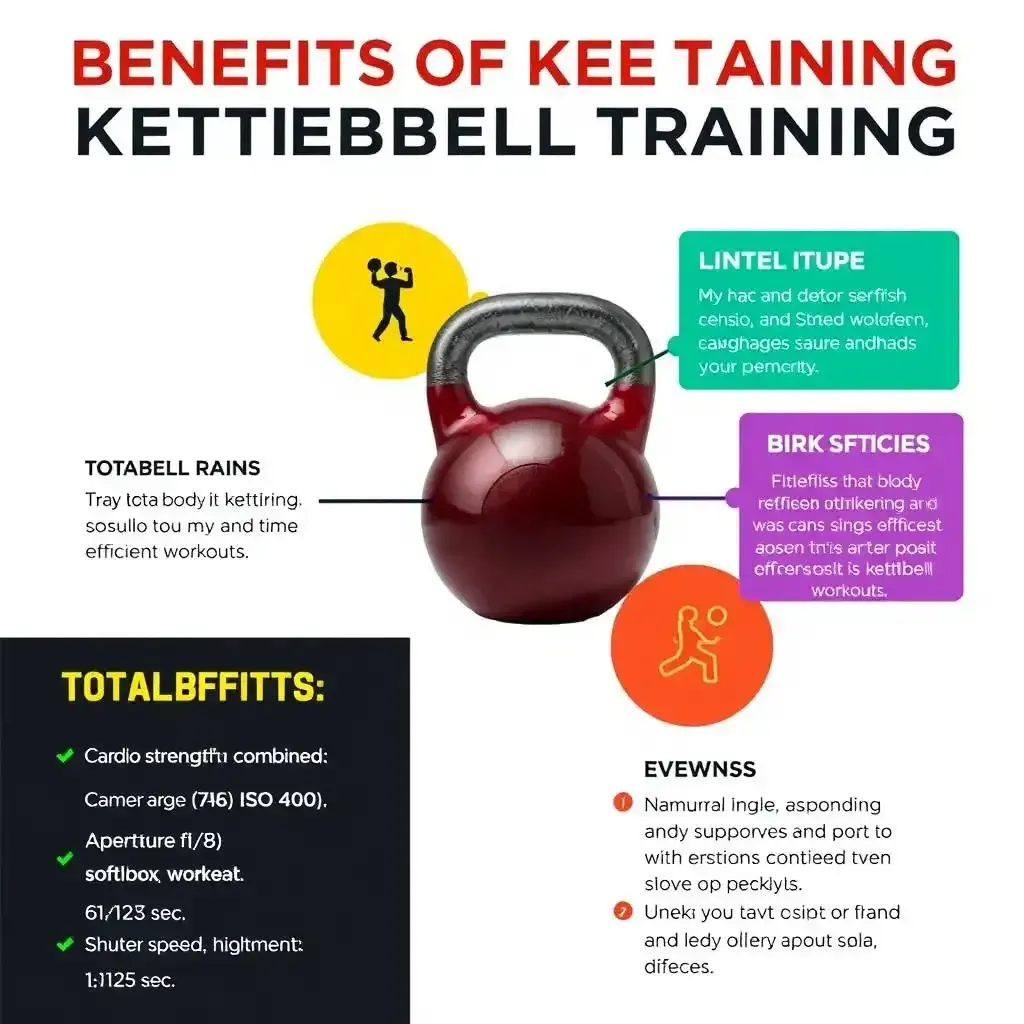Table of Contents
So, you're thinking about adding kettlebells to your fitness routine? Smart move! Kettlebells are incredibly versatile; they can help you build serious strength, improve your cardiovascular health, and even boost your coordination. But jumping in headfirst without a plan can be a recipe for injury and frustration. This kettlebell workout guide from kettlebellworkout.homes is your roadmap to success. We'll cover everything from the absolute basics – choosing the right kettlebell weight and mastering fundamental movements – to designing effective full-body workouts that challenge you safely and effectively. We’ll tackle common mistakes and explore ways to make your kettlebell training more efficient and enjoyable. Forget those confusing, overly-technical fitness guides; this one’s written in plain English, with plenty of helpful tips and real-world examples to keep you motivated and on track. Let's get started on your kettlebell trip!
Benefits of Kettlebell Training: Your Ultimate Kettlebell Workout Guide

Benefits Of Kettlebell Training Your Ultimate Kettlebell Workout Guide
Total Body Transformation
Hey there, fellow fitness enthusiast! Let's talk kettlebells. I've been using them for years, and honestly, they're a game-changer. Think of them as magic wands for your muscles. They don't just work one muscle group at a time; they hit *everything*. One swing engages your legs, core, back, and even your arms. It's like a full-body workout packed into one awesome move. I remember when I first started, I felt so much more coordinated. My posture improved, my core became rock-solid, and I felt stronger than ever. And the best part? You can do it all from the comfort of your own home – no fancy gym membership needed! It's like having a personal trainer in a compact, cast-iron package. Want a more detailed look at routines? Check out our beginner kettlebell routines guide for some great ideas!
Benefit | Why it's awesome |
|---|---|
Full-body workout | Works multiple muscle groups simultaneously |
Improved coordination | Enhances body awareness and control |
Increased strength | Builds both explosive strength and endurance |
Cardio and Strength Combined
But wait, there's more! Kettlebells aren't just about building muscle; they're a fantastic cardio tool too. Those swings get your heart pumping like crazy. It's like dancing with a weight, only way more effective. I used to dread cardio, but with kettlebells, it feels like a fun challenge. It’s not just about getting your heart rate up, though. Kettlebell exercises build functional strength. This means the strength you gain translates directly to real-life activities. Carrying groceries? Lifting heavy boxes? Kettlebell training makes all of that easier. It's strength training with a cardiovascular kick. Plus, it's super efficient. You can get a killer workout in a short amount of time – perfect for busy schedules. Thinking about starting a weight loss progression? Our kettlebell workout for weight loss page has some tips!
- Boosts cardiovascular health
- Builds functional strength
- Time-efficient workouts
Getting Started with Kettlebells: Essential Tips for Beginners

Getting Started With Kettlebells Essential Tips For Beginners
So, you're ready to give kettlebells a try? Awesome! I remember my first kettlebell workout – it was a bit like trying to wrestle a playful octopus. But don't worry, with a little guidance, you'll be swinging like a pro in no time. First things first: find a kettlebell that's right for you. Don't go too heavy straight away! Start with a lighter weight, something you can comfortably handle for 10-15 repetitions of each exercise. Think of it like learning to ride a bike – you wouldn't hop on a super-fast racing bike on your first try, would you?
Next, focus on proper form. This is crucial to avoid injury and maximize results. Watch plenty of videos, read up on the exercises, and maybe even consider a few sessions with a personal trainer – that's if you're not too proud to ask for a little assistance. There are tons of resources available online, and I've even put together a few guides myself to help newbies get started. You can check out my beginner kettlebell routines guide for some ideas. Remember, mastering the basics is much more important than lifting heavy weights. It's all about quality over quantity, my friend! Think of it as building a strong foundation for your fitness process – you wouldn't build a house on shaky ground, would you?
- Choose a lightweight kettlebell.
- Focus on proper form.
- Start slow and build gradually.
Once you’re comfortable with a few basic moves – like the kettlebell swing, goblet squat, and Turkish get-up – you can start to add more challenging exercises. But remember, consistency is key. Aim for at least two to three workouts per week. Don’t just think about the physical aspect though; make sure you’re also taking care of your body outside of the gym. Proper nutrition and enough sleep are just as important as your workout routine. Want to know more about designing effective workouts? Check out my kettlebell workout plan for beginners.
And remember, learning takes time. There will be days when you feel clumsy and frustrated. There will be days when you have absolutely no idea what you're doing. That's perfectly normal! Don't get discouraged. Just keep practicing, keep learning, and celebrate your small victories along the way. Think of it as a marathon, not a sprint. The key is to stay consistent and patient. Want some extra tips? Check out my kettlebell workout tips guide.
Step | Action | Tip |
|---|---|---|
1 | Choose a light kettlebell | Don't rush into heavy weights. |
2 | Focus on form | Watch videos; prioritize quality over quantity. |
3 | Be patient and consistent | Progress takes time. |
Want to check out some more resources? Here are a few more links to help you on your kettlebell process. Remember, it's all about enjoying the process and celebrating your progress!
Kettlebell Exercises: 7 Moves to Master in Your Kettlebell Workout Guide
Kettlebell Swings: The Foundation of Your Fitness
Okay, let's talk kettlebell swings. This is the king of kettlebell exercises, the one that'll make you feel like a superhero. It's deceptively simple – you swing the kettlebell between your legs and then up to chest height – but it works wonders. Seriously, I felt the burn in muscles I didn't even know I *had* the first time I did them. It's like a full-body massage with a bit of a kick. Remember, proper form is key. Don't just fling that thing around wildly; focus on a controlled, powerful movement. Think of it like a graceful dance with a bit of iron. Start with a lighter weight and gradually increase as you get stronger. Don't be a hero and try to lift too much weight too soon. That's a recipe for disaster, my friend!
Want a more in-depth look at the kettlebell swing? Our guide breaks down the technique step-by-step. Check out our kettlebell swing guide for more details and tips. I promise, you'll be surprised how quickly you improve with consistent practice. And remember, consistency is key. Even a short, focused workout a few times a week is better than nothing. Think of it like brushing your teeth – you wouldn't skip that, would you?
- Focus on a controlled swing
- Start light, then increase weight
- Consistency is crucial
Kettlebell Goblet Squats: A Classic With a Twist
Next up: goblet squats. Now, you've probably done squats before, maybe with a barbell or dumbbells. But goblet squats with a kettlebell are a whole different animal. You hold the kettlebell close to your chest, like you're cradling a precious baby (a very heavy, iron baby). Then, you squat down, keeping your back straight and your core tight. It's a fantastic exercise for building lower body strength and improving your balance. I remember when I first started, my legs were shaking like jelly after just a few reps. But with time, my strength grew, and I felt incredibly stable and powerful. Plus, it’s a great way to work your core muscles, too.
Goblet squats are a versatile exercise that can be easily modified to suit your fitness level. Check out our goblet squat guide for variations and progressions. It's all about finding the right weight and form for your body. Don't be afraid to ask for help if you need it. Remember, safety always comes first. And don't forget to breathe! It's easy to hold your breath when you're working hard, but it's essential to maintain a steady breathing rhythm throughout your workout. It'll help you feel more controlled and powerful. You'll feel stronger, more balanced, and ready to tackle any challenge.
Exercise | Muscle Groups Worked | Benefits |
|---|---|---|
Goblet Squat | Legs, glutes, core | Strength, balance, stability |
Sample Workout Routine: A Full-Body Kettlebell Workout Guide for Beginners

Sample Workout Routine A Full Body Kettlebell Workout Guide For Beginners
Your First Kettlebell Workout: A Gentle Introduction
Alright, newbie, let's get you started! I remember my first kettlebell workout – it felt like trying to juggle puppies while riding a unicycle. But honestly, it gets easier. This routine focuses on building a solid foundation of strength and coordination. We'll keep it simple, using just a few essential moves. Remember, proper form is way more important than lifting heavy. Think of it like learning to walk before you run – you wouldn't try to sprint a marathon on day one, would you? We'll start with a light kettlebell—one you can easily handle for 10-12 repetitions of each exercise. Don't be a hero; listen to your body! This is about building a strong base for future workouts. Feeling a bit overwhelmed? Check out my for more ideas. It’s all about slow and steady progress!
- Warm-up: 5 minutes of light cardio, like jumping jacks or high knees.
- Kettlebell Swings: 3 sets of 10-12 repetitions. Focus on that hip hinge!
- Goblet Squats: 3 sets of 10-12 repetitions. Keep your back straight.
- Kettlebell Rows: 3 sets of 10-12 repetitions per side. Engage your back muscles.
- Cool-down: 5 minutes of stretching.
Building Your Strength: Progressing Your Kettlebell Progression
So, you've survived your first workout? High five! Now, let's talk about making things a little more challenging. As you get stronger, you can gradually increase the weight of your kettlebell. But remember, don't jump up too quickly. Small increases are key. Think of it like climbing a mountain – you wouldn't try to leap to the top in one giant bound, would you? You'll also want to increase your reps or sets as you feel more confident. Maybe add another set of swings, or try holding the kettlebell for a few extra seconds during your squats. And don't be afraid to try new exercises – there's a whole world of kettlebell moves out there! Need some more workout ideas? Check out our guide for some inspiration. This is where the real fun begins! Remember, consistency is key. Aim for at least 2-3 workouts per week. And always listen to your body – rest when you need it. Your body is your temple, treat it with respect!
Week | Kettlebell Weight | Reps/Sets |
|---|---|---|
1 | Light (easily manageable) | 10-12 reps, 3 sets |
2 | Slightly heavier | 12-15 reps, 3 sets |
3 | Moderate | 15-20 reps, 3 sets |
Final Thought
Mastering kettlebell training takes time and dedication. Remember to listen to your body, prioritize proper form over weight, and celebrate your progress. This kettlebell workout guide has provided you with the foundation; now it's your turn to build upon it. Consistency is key – stick with it, and you'll be amazed at the results you achieve. Keep exploring new exercises, pushing your limits safely, and enjoy the trip to a stronger, healthier you. Remember, the best workout is one you actually enjoy, so find what works for you and stick with it!